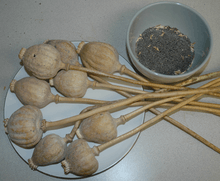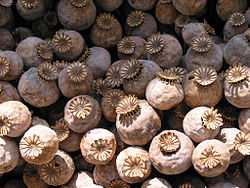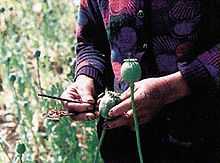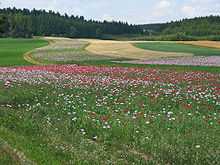Poppy straw


Poppy straw (also opium straw, poppy capsule, poppy chaff, poppy head, poppy pod) is opium poppy (Papaver somniferum) that is harvested when fully mature and dry, minus the ripe poppy seeds. An agricultural by-product of the poppy seed harvest, the straw was a waste product before the 1930s when a chemical process became available to extract morphine from it. Poppy straw consisting mainly of the capsule soon became a valuable source of morphine. Today, poppy straw is a major source of many opiates and other alkaloids. It is the source of 90% of the world supply of legal morphine (for medical and scientific use)[1] and in some countries it also is a source of illegal morphine, which could be processed into illegal heroin).[2]
The 1961 Single Convention on Narcotic Drugs defines poppy straw as "all parts (except the seeds) of the opium poppy, after mowing".[3]
Harvesting



Traditional harvesting of opium poppies to produce opiates involved the labor-intensive work of making shallow cuts in the immature fruits (seed pods) so that the latex would leak out and dry, then returning the following day to scrape off the dry latex, known as raw opium.
Harvesting of poppy straw is an alternative, largely mechanized method. The plants are allowed to mature fully, then a machine is used to harvest the entire field. The ripe poppy seeds are separated out by threshing and winnowing, and the remainder is poppy straw. Poppy straw usually consists of only the above ground parts of the plant, but the roots may be harvested as well. Some producers mow the plants high, so that the harvest consists almost entirely of the fruits (seed pods), omitting the stalks, leaves, and roots. Poppy straw is then processed in a manner similar to opium to extract opiates and other alkaloids (see Morphine).
Avoiding the labor-intensive harvesting of opium by hand was the topic of research for almost 100 years.[4] This research was of notable interest in those countries where opium poppy was an important oilseed crop but due to high labor costs the harvesting of opium was not economic. What was needed was a process that enabled commercial extraction of opiates from opium poppies directly rather than from (comparatively pure) opium.
By the 1940s, commercial production of morphine from poppy straw had spread from Hungary to Poland and finally most countries where poppies are grown on a large scale primarily for their seeds. By 1950, about 10% of the poppy seed harvest of those countries was also yielding morphine. Based on average yields and the reported production of poppy seed in 9 European countries, the potential production of morphine from those crops was estimated to be 148,800 kilograms (328,000 lb). However, in 1950 the actual production of morphine from poppy straw was reported to be 11,663 kilograms (25,713 lb).[5]
As of 1950, the average annual yield per hectare was estimated to be 675 kilograms (1,488 lb) poppy seed and 450 kilograms (990 lb) poppy straw (dry capsule chaff), which in turn was estimated to yield about 1.5 kilograms (3.3 lb) of morphine (in good years).[5]
Processing
The first commercial process by which opiates are extracted from poppy straw was invented in Hungary by János Kabay.[4][6] This process, known as the "poppy straw method",[7] remains in use today. Kabay applied his new process initially to fields of opium poppies between the stages of flowering and maturity, while the fruits were green. This had several disadvantages: the immature poppy seeds could not be winnowed, so not only was the seed crop lost but their poppyseed oil interfered with the process; the abundant chlorophyll in the green plants also interfered; and an entire year's crop had to be processed in two months, as it reached the fruit stage. Kabay soon found that the process could be applied to poppy straw residue from the poppy seed harvest, and thereby eliminate all these disadvantages.
Poppy straw is first pulverized, then washed as many as six to ten or more times in water and/or various acids and other chemicals, to produce poppy straw concentrate (PSC, also known as concentrate of poppy straw, CPS). Dried, the concentrate is a beige to brown powder. It contains salts of various alkaloids, and can range from nine to 30 times the morphine concentration of poppy straw. Opium concentrates using solvents other than acidifed or plain water are often but not necessarily called PSC.[8]
Poppies of the Norman and Przemko strains contain much higher amounts of thebaine and oripavine and have morphine concentrations down to under 1 per cent. versus up to 26 per cent in high-morphine strains. At least one manufacturer, Tasmanian Alkaloids, produces both high-morphine and high-thebaine/oripavine types of poppy straw concentrate; the latter is used by pharmaceutical manufacturers to make semi-synthetic and synthetic opioids such as oxycodone, etorphine, butorphanol and a number of others.
PSC is an alternative to bricks of opium, as an alkaloid source in most but not all of the production methods to isolate natural alkaloids from the opium poppy. A notable exception is thebaine, which is present in far larger fractions in opium than in poppy straw. Morphine, being a large fraction of the alkaloids found in mature poppy capsules, is produced commercially from either opium or concentrated poppy straw.[9] To extract morphine, PSC is dissolved in water and treated with other chemicals to obtain the next intermediate, calcium morphenate or less frequently sodium morphenate, which is then further treated to purify the drug and convert it to the desired morphine salt or base. Processes for extracting other alkaloids, such as codeine and noscapine, use other chemicals and/or optimal solution pH.
Poppy straw crops
Annual world production of opium and poppy straw, both legal and illegal, is tabulated by the United Nations Office on Drugs and Crime, and reported in its annual World Drug Report. The quantity of poppy straw produced is typically given as "opium equivalents". The 2002 World Drug Report estimate of the total world opium production, including opium equivalents of poppy straw, was 42,600 metric tons (41,900 long tons) in 1906/07 and 12,600 metric tons (12,400 long tons) in 2007. The 2007 production consisted of 8,870 metric tons (8,730 long tons) of illegal opium, 3,420 metric tons (3,370 long tons) of opium equivalent from legal poppy straw, and 300 metric tons (300 long tons) of legal opium.[1] Thus, over 90% of the world production of legal opiates, including medical morphine, now is produced from poppy straw.
With the establishment of poppy straw as the source of the majority of natural morphine and other opiates, much of the world production of opium is destined for illicit uses. In 1981 dried capsules were found being sold for decoration in Sweden, that had been lanced 2 to 5 times with a tool having 3 to 4 blades and the opium scraped off. The morphine content of these capsules was 0.15 - 0.34%, comparable to domestic Swedish capsules not lanced. In India, poppy straw from lanced capsules had a morphine content of at least 0.2%. These levels of morphine obtained from "exhausted" plants suggests that for producers of licit opium, poppy straw may be a profitable second crop.[3]
As of 2005, India was the only country producing licit opium (opium gum) for both domestic use and export. Licit opium was produced also in Democratic People's Republic of Korea for domestic use, and Japan for maintenance of the pertinent technology (small quantities). Opium poppies were grown principally for extraction of alkaloids (from poppy straw) in 9 other countries: Australia, China, France, Hungary, Slovakia, Spain, the Republic of Macedonia, Turkey, and the United Kingdom. China ceased producing licit opium after 2001. Opium poppies grown principally for the seed crop, with licit poppy straw as a by-product, were produced in Czech Republic, and Serbia and Montenegro. Another 6 countries cultivated opium poppies solely for the poppy seed or horticultural purposes, without extraction of alkaloids from poppy straw: Austria, Estonia, Germany, Netherlands, Poland, and Ukraine.[10] Illicit production of Polish heroin and other products derived from poppy straw is an ongoing problem in Poland.[2]
The production of licit opium in India was in accord with terms of the 1961 Single Convention on Narcotic Drugs. After the opium was harvested, the plants were allowed to mature and harvested for poppy seeds. The sale of poppy seeds delivered a significant proportion of the income from the licit opium crop. Unknown fractions of both the opium harvest and poppy straw residue of the poppy seed harvest were diverted to illicit uses.[10]
The production of illegal opium from poppy straw is limited. It is reported primarily in clandestine laboratories in Moldova, the Russian Federation, and Ukraine, using domestic poppy straw.[2]
Derived products
A common method of producing laudanum involves dissolving the PSC or latex-derived opium in alcohol and either being allowed to sit for up to a week and periodically agitated, using fresh alcohol to do multiple washes, or refluxing. The original patents for laudanum in various countries refer to soaking poppy straw in varying levels of pulverisation in plain water for a week then evaporating the water to obtain the gummy or powdery brown concentrate.
Recreational use
Poppy tea and its variants can be said to be an incomplete and/or relatively crude form of PSC aqueous solution.
Home-made poppy straw extracts including Kompot are widely used among IV drug users in eastern Europe, including Ukraine[11][12] and Poland.[13]
Tracing of illicit drugs
Poppy straw is a raw material from which illegal heroin may be produced. The alkaloid profiles of poppy straw and opium are similar, but preliminary research suggests they can be distinguished by relative quantities of alkaloids.[14] Based on the presence of the alkaloid oripavine in some opium poppies, it has been suggested that illegal heroin seized in Australia was produced from a legal poppy straw crop stolen in Tasmania a few years earlier.[15]
References
- ↑ 1.0 1.1 http://www.unodc.org/documents/wdr/WDR_2008/WDR2008_100years_drug_control_achievements.pdf
|contribution-url=missing title (help). World Drug Report. United Nations Office on Drugs and Crime. 2008. p. 213. - ↑ 2.0 2.1 2.2 World Drug Report. United Nations Office on Drugs and Crime. 2009. p. 37.
- ↑ 3.0 3.1 Bruhn, J. G.; Nyman, U. (1981). "A note on the morphine content of lanced poppy capsules purchased as "dried flowers"". Bulletin on Narcotics (2): 41–44.
- ↑ 4.0 4.1 Bayer, Istvan (1961). "Manufacture of alkaloids from the poppy plant in Hungary". Bulletin on Narcotics 13 (1): 21–28.
- ↑ 5.0 5.1 Anonymous (1953). "The manufacture of morphine from poppy straw". Bulletin on Narcotics (3): 16–18.
- ↑ Bayer I (July 1987). "[János Kabay and the poppy straw process. Commemoration on the 50th anniversary of his death]". Acta Pharmaceutica Hungarica (in Hungarian) 57 (3–4): 105–10. PMID 3314338.
- ↑ "1. The world drug problem: A status report". World Drug Report. United Nations Office on Drugs and Crime. 2004
- ↑ "Part IV, Statistical information on narcotic drugs". International Narcotics Control Bureau, Technical Reports. 2008.
- ↑ Freemantle, Michael (2005). "The Top Pharmaceuticals That Changed The World: Morphine". Chemical and Engineering News 83 (25).
- ↑ 10.0 10.1 "India". United Nations Office on Drugs and Crime. September 2005. Retrieved 2009-12-16.
- ↑ Booth RE, Kennedy J, Brewster T, Semerik O (2003). "Drug injectors and dealers in Odessa, Ukraine". Journal of Psychoactive Drugs 35 (4): 419–26. doi:10.1080/02791072.2003.10400488. PMID 14986870.
- ↑ Dumchev KV, Soldyshev R, Qian HZ, Zezyulin OO, Chandler SD, Slobodyanyuk P, Moroz L, Schumacher JE (2009). "HIV and hepatitis C virus infections among hanka injection drug users in central Ukraine: a cross-sectional survey". Harm Reduction Journal 6: 23. doi:10.1186/1477-7517-6-23. PMC 2741433. PMID 19698166.
- ↑ Taracha E, Habrat B, Chmielewska K, Baran-Furga H (2005). "Excretion profile of opiates in dependent patients in relation to route of administration and type of drug measured in urine with immunoassay". Journal of Analytical Toxicology 29 (1): 15–21. doi:10.1093/jat/29.1.15. PMID 15808008.
- ↑ Reid RG, Durham DG, Boyle SP, Low AS, Wangboonskul J (December 2007). "Differentiation of opium and poppy straw using capillary electrophoresis and pattern recognition techniques". Analytica Chimica Acta 605 (1): 20–7. doi:10.1016/j.aca.2007.10.023. PMID 18022406.
- ↑ Odell LR, Skopec J, McCluskey A (March 2008). "Isolation and identification of unique marker compounds from the Tasmanian poppy Papaver somniferum N. Implications for the identification of illicit heroin of Tasmanian origin". Forensic Science International 175 (2–3): 202–8. doi:10.1016/j.forsciint.2007.07.002. PMID 17765420.